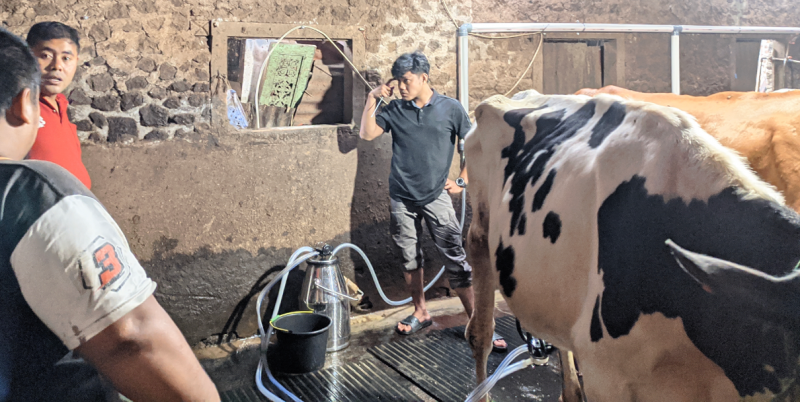UNESA Students Design Semi-Automatic Milking Machine, Already Used by SMEs

Unesa.ac.id, SURABAYA—A team of students from Universitas Negeri Surabaya (UNESA) recently designed a semi-automatic cow milking machine to facilitate the production process for small and medium enterprises (SMEs) in dairy farming. This innovation stems from their concern about the condition of SMEs in the field, which still rely on conventional or manual labor.
This milking machine innovation was created by Akdri Bagus Zulvikar, Ahmad Sabili, M. Shihab Akbar, Muhammad Rardin, and Abdul Latif Sanni. They were supervised by Novi Sukma Drastiawati, S.T., M.Eng. The supervising lecturer said that the innovation was based on the findings of her students in the field.
"Field findings show that dairy SMEs are still very traditional, requiring a lot of labor and time. This is the era of technology, and products in the market are competitive. To compete, SMEs need an effective and efficient production process without compromising the quality of the milk produced," she said.
From these conditions, the students in the UNESA innovation team conducted research and in-depth studies to create a special machine that helps the dairy production process. "We came up with the idea and immediately made it. Then we offered this tool to SMEs. It turned out that many responded positively," said Novi.

The machine, he continued, has already been used by dairy SMEs, one of which is in Singolangu, Sarangan, Plaosan District, Magetan. Their response to the machine has been very positive and they feel helped. Besides being able to work faster, the labor required is relatively small. The machine uses relatively low power, so it does not significantly impact electricity costs.
The machine has several advantages. First, the electrical power required is relatively small but has good suction power. Second, the rubber used on the cow's teats is adjusted to the condition of the cow's teats, not too hard or soft. Third, each milk suction tube is prepared for different types of cows.
Fourth, users can adjust the suction speed through the pulsator. Fifth, the pumping process is not noisy. Sixth, the machine maintenance process is relatively easy, using widely available hydraulic oil. Seventh, the machine components use food-grade materials, so they are safe and the milk produced is not contaminated with bacteria.
So how does it work?
First, clean the cow's teats, then attach the milk claw to the cow's teats to be milked. Second, activate the machine by plugging the vacuum pump switch into the socket. Third, wait for the machine to reach a suction power of -50-(-60) kpa (kilopascal) air pressure unit. Fourth, open the valve on the vacuum tube and wait for the suction power to reach the required pressure. Fifth, attach the milk claw to the cow's teats and start the suction process.
The woman born in Blitar continued that the machine will continue to be developed and perfected from semi-automatic to fully automatic. She hopes that the machine can also be mass-produced and used by many dairy SMEs in various regions. []
***
Writer: Saputra
Editor: @zam Alasiah*
Photo: FT UNESA Innovation Team
Share It On: